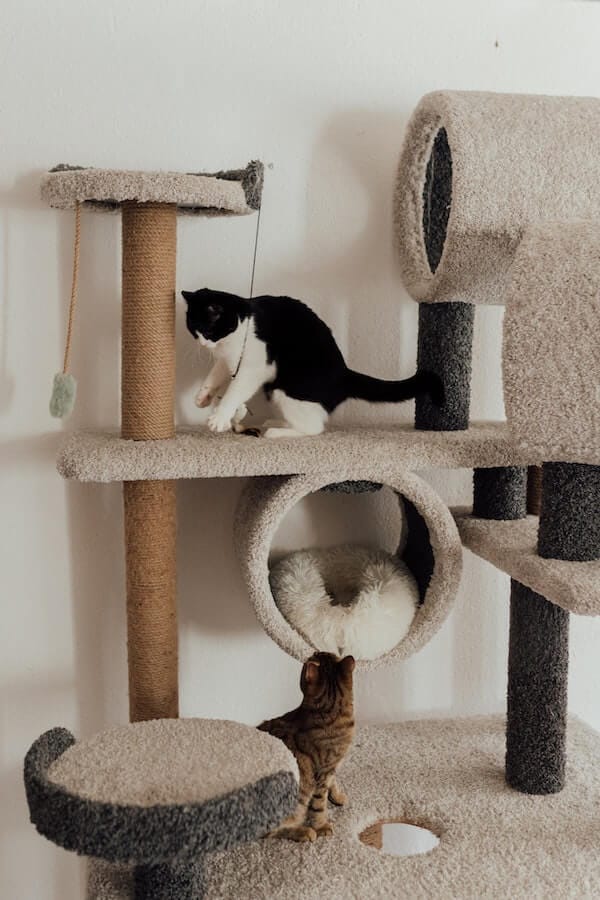
Introducing a new cat to your household can seem like a daunting task, but it doesn’t have to be. So how to introduce a new cat to your household in a peaceful way?
Before buying a new cat, it is common for cat parents to go through this dilemma.
With the right tips and tricks, you’ll be able to make sure that the transition is smooth and stress-free for both you and your feline friend!
Read on for some helpful advice on how to go about introducing a new cat into your home.
Let’s get started!
How to introduce a new cat to your household?

Introducing a new cat to your home can be both exciting and scary! But don’t worry – we have the perfect 10-step guide to make sure everything goes as smoothly as possible.
1. Prepare the space:
It’s important that your new feline friend has their own dedicated space during the introduction period. This will give them a safe place to retreat if they feel uncomfortable or overwhelmed by their new environment.
2. Let them explore:
When you bring your cat home, allow them time to sit down and explore their surroundings at their own pace without disturbance. It takes cats some time to get used to a new area, so giving them this opportunity is essential from the beginning.
3. Scent swapping:
Swapping items between your current and new cat will allow them to become familiar with each other’s smell. Place blankets or toys in the same area for both cats to sniff and explore.
4. Provide plenty of food stations:
Make sure there is more than enough food, water, and litter boxes scattered around the house so that both cats can eat without feeling threatened by one another.
5. Limit their contact:
While introducing a new cat to your home, it’s important to limit physical contact until they feel comfortable around each other. You can start by placing the cats on opposite sides of a doorway or use baby gates when needed.
6. Make time for play:
Playing together helps cats learn how to communicate with one another. It’s important that you are the one initiating playtime and make sure not to overwhelm either cat with too much physical contact.
7. Stick to a routine:
Cats need structure in order to feel safe, so establish a routine as early as possible. Feeding and playing at the same time each day will help them get used to each other more quickly.
8. Offer rewards:
Reward your cats for positive behavior towards one another, such as when they mutually groom or lay near each other without getting into any fights. This helps build trust between the two of them.
9. Monitor their interactions:
It’s important that you stay nearby during their first few meetings but out of sight so that they don’t feel threatened by your presence.
10. Have patience:
Introducing a new cat to your home can be a long process, so make sure you have plenty of patience and understand that it may not happen overnight. With enough time and love, these two cats will soon become best friends!
How long does it take a new cat to get used to?
It typically takes a new cat about two weeks to adjust to its new environment. During this time, it’s important for owners to be patient and understanding.
The first few days should be spent allowing the cat to explore and remain stress-free as much as possible.
This includes providing plenty of hiding spots, fresh food and water, a litter box in an easily accessible location, and toys or other forms of enrichment that can provide comfort during this period.
Owners can slowly introduce their newest family member to daily routines such as feeding times and playtimes over the following days.
It is generally best not to force physical contact but let the cat come around on its own terms by sitting quietly nearby and offering treats or affection when appropriate.
Do cats get upset when you get a new cat?

Yes, cats can get a bit jealous when you bring home a new cat. In fact, it’s like introducing a new sibling into the family!
Cats are territorial creatures and may feel threatened by the presence of another feline in their space.
You’ll likely notice your cat’s behavior changing when they meet the newcomer.
They might become more vocal or start to exhibit signs of aggression like growling or swatting at the other cat.
If they act out too much, they might even be banished from the room so that everyone can get used to each other slowly and safely.
However, there is hope! With patience and understanding, your cats will eventually learn to coexist peacefully in the same household.
Is it better to have two cats of the same gender?

If you’re thinking of getting two cats, it’s natural to ask: should they be of the same gender? Well, there’s no one-size-fits-all answer.
It really depends on your specific situation and plans for the future. To get a male or a female cat is a question that clouds the decision of many cat lovers.
Let’s have a look at the pros and the cons of getting same-gender cats.
Pros:
- If you keep two cats of the same gender, they are less likely to breed and produce unexpected litters down the line. This means fewer trips to the vet (and associated costs) in order to spay or neuter them!
- Two cats of the same gender can get along better than a pair that is different genders — female cats may not have any interest in competing for a male cat’s attention.
- Having two cats of the same gender can help to ensure that any potential fight between them won’t be over a mate.
Cons
- Having two cats of the same gender can also increase their interest in grooming each other — sometimes resulting in over-grooming or hair loss.
- They may become more territorial and display more aggressive behaviors when another cat isn’t around to play with.
- If you don’t plan on neutering either of your cats, it’s important to keep them separated even if they are the same gender; otherwise, you run the risk of unwanted pregnancies.
Ultimately, it comes down to what works best for you and your cats. If you’re only getting one cat or if you always plan on separating them, two cats of the same gender can be a good option.
But if you want your cats to live together and play with each other, getting two cats of different genders might be better for everyone.
Conclusion

Now that you know how to introduce a new cat to your household try to make introductions easier.
This can be done by providing each cat with its own food and water bowls, litter boxes, DIY toys, and other items that separate them from each other.
This will help your cats become aware of one another without feeling overwhelmed.
In the end, it’s all about helping your cats adjust to living together in harmony. With enough time and effort, you can make sure everyone feels comfortable in their new multi-cat home!
Do also remember that cats can be very sensitive creatures and sometimes it may take them a bit longer to adjust to the new situation than humans.
Be sure to show patience and understanding when introducing a new cat, as the process can take some time.
Above all, don’t forget lots of love and attention for your cats – no matter how many you have in your home! 🙂


GIPHY App Key not set. Please check settings